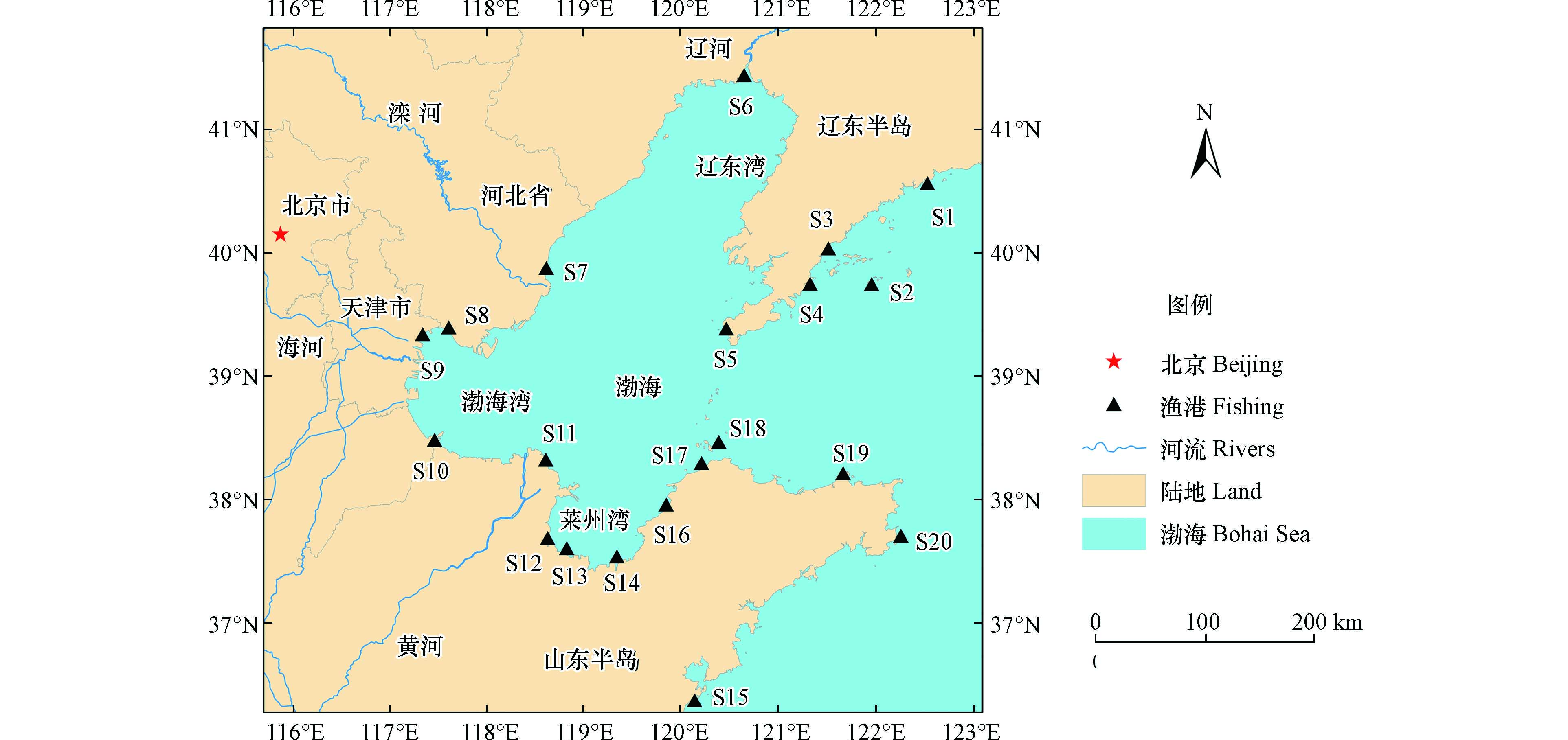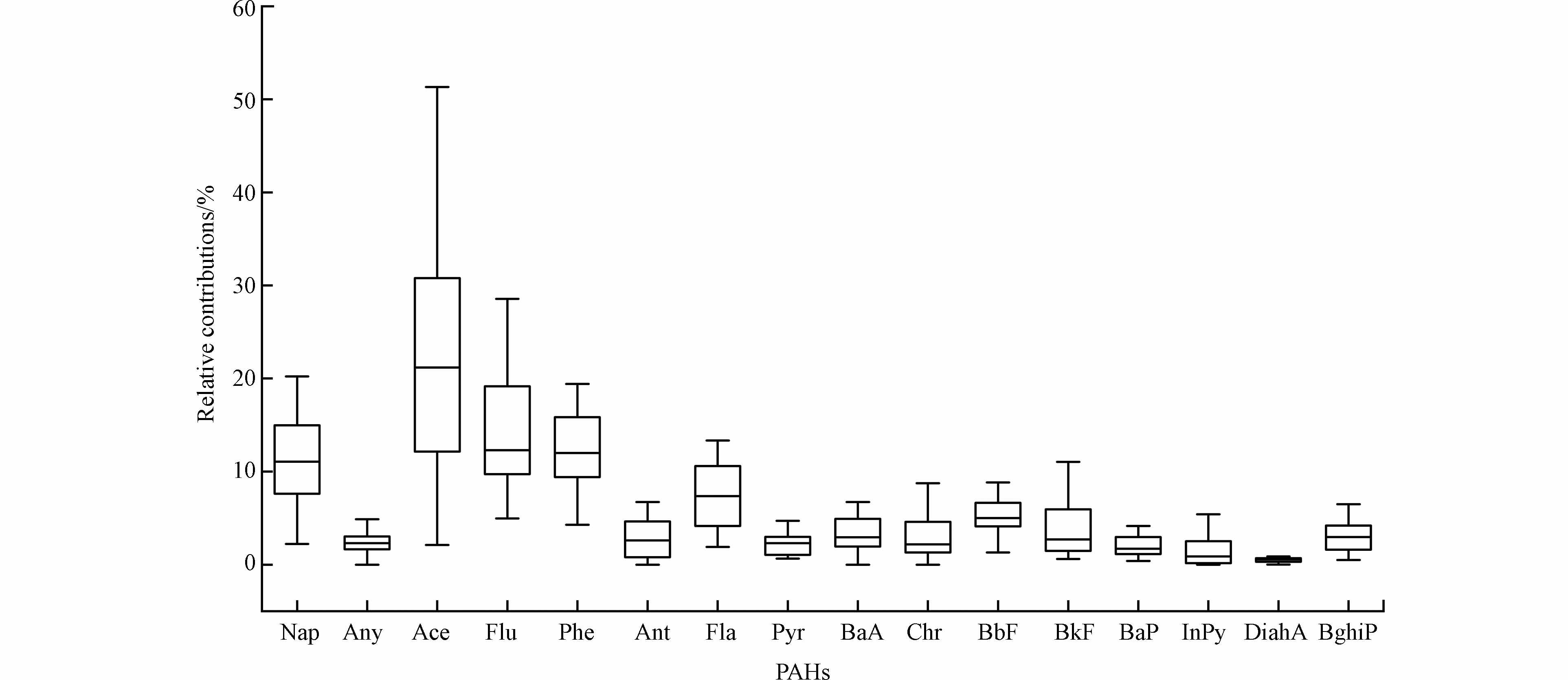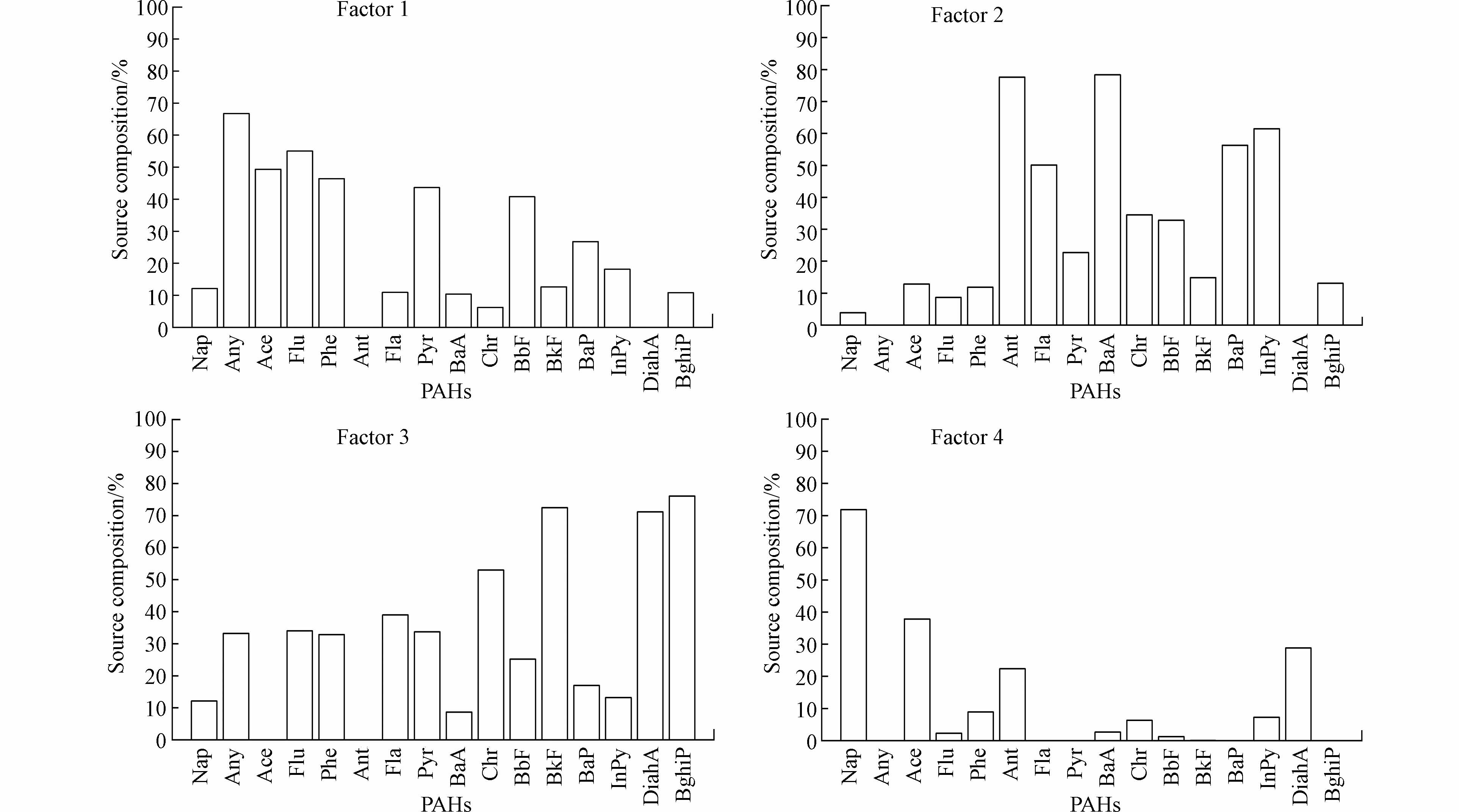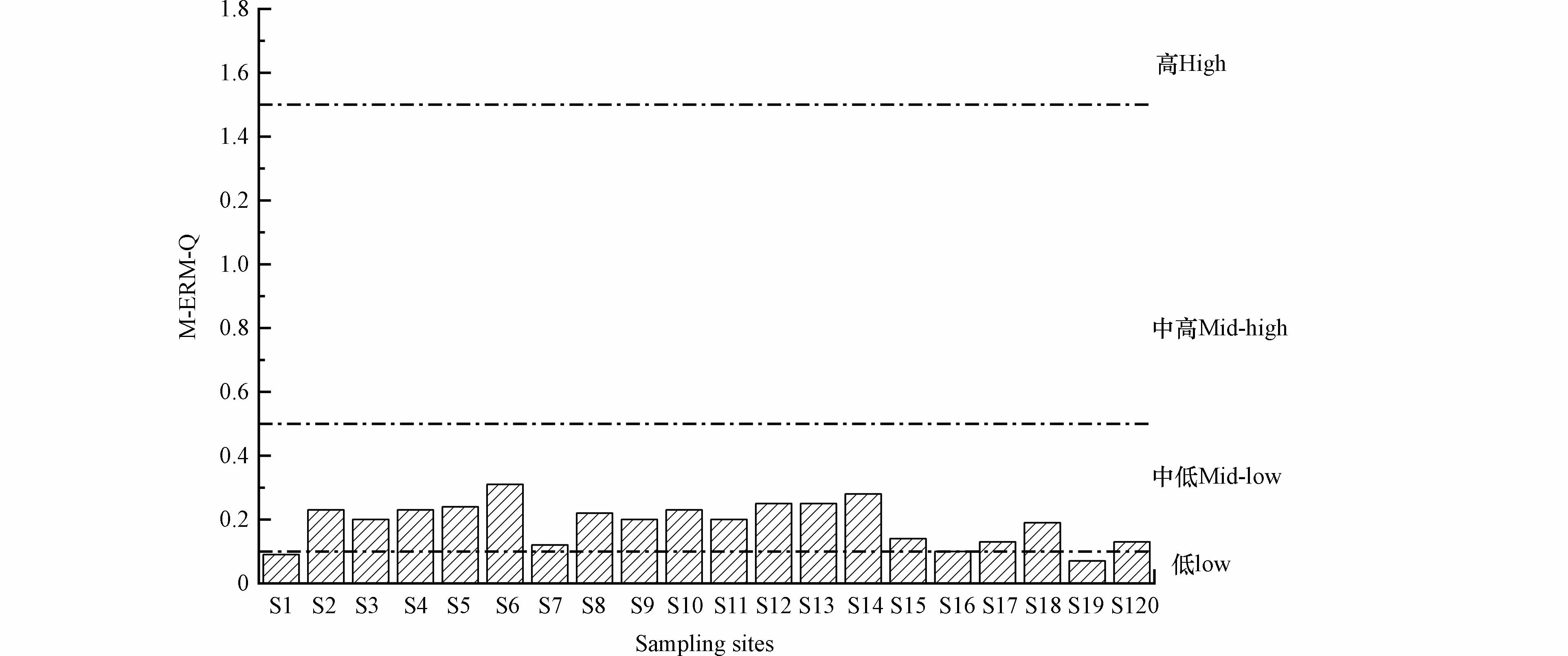-
多环芳烃(polycyclic aromatic hydrocarbons, PAHs)是一类由两个或两个以上苯环稠合在一起的有机化合物[1], 由于其具有高沸点、疏水性、亲脂性和持久性等特点, PAHs进入环境后极易吸附在颗粒物上, 并长期存在于环境介质中. 有研究表明,由于其亲脂疏水性, 导致PAHs容易在不同的环境介质中积累, 还可随大气沉降进行远距离的迁移. PAHs对人类和其他生物体具有毒性和免疫抑制作用, 由于其“三致”效应(致畸、致癌、致突变)的危害[2], PAHs污染引起了人类社会的极大关注, 而且美国环境保护署在1979年把16种PAHs列入优先控制名单, 我国也将7种PAHs列入优先控制污染物名单[3]. PAHs的来源可以分为自然源和人为源. 森林火灾和火山喷发等过程中的排放被认为是自然源, 人类社会活动过程中的排放被认为是人为源 (如化石燃料燃烧、石油开采及其副产品的泄漏、污水排放和机动车尾气排放等). 其中, 人为源被认为是PAHs的主要来源[4]. 由于PAHs特点, 一旦进入海水环境中, 容易被海水中的颗粒物吸附, 进而积累到沉积物中[5], 对海洋底栖生物产生毒害作用. 此外, 沉积物中的PAHs还会通过解吸作用再次释放到水体中. 因此, 研究沉积物中的PAHs对保护海洋环境有着重要意义.
环渤海地区是我国重要的海洋经济发展区域, 具有丰富的海洋资源和渔业资源, 也是我国北方经济最活跃的地区. 随着海洋经济发展和人类活动增加, 渤海海域的环境问题日益受到关注, 特别是沿岸渔港的污染问题越来越严重. 渔港是众多渔船的集散地, 大型船只动力燃料主要为柴油, 燃料不完全燃烧和船舶含油污水等释放到海水中, 都极易造成沉积物中PAHs的污染和潜在的生态风险. 目前, 已有研究报道了渤海海域沉积物中的PAHs含量[6-8], 但对渔港沉积物的研究极为有限. 因此, 本文以环渤海渔港表层沉积物为研究对象, 研究PAHs的含量、组成和分布特征, 阐明其可能来源并进行风险评价, 为环渤海生态环境保护和治理提供科学依据.
-
2019年5—6月, 在环渤海的20个渔港(S1—S20)共采集65个沉积物样品(0—5 cm), 每个渔港3—4个样品, 均采集平行样品。20个渔港中包括中心渔港11个和一级渔港9个, 采样位置如图1. 样品运回实验室之后, 经过冷冻干燥处理, 研磨并过0.2 mm筛后冷冻保存待测.
-
美国环保署优先控制16种PAHs混标购自AccuStandard公司, 包括:萘(Nap)、苊烯(Any)、苊(Ace)、芴(Flu)、菲(Phe)、蒽(Ant)、荧蒽(Fla)、芘(Pyr)、苯并[b]蒽(BaA)、䓛(Chr)、苯并[b]荧蒽(BbF)、苯并[k]荧蒽(BkF)、苯并[a]芘(BaP)、茚并[1,2,3−cd]芘(InPy)、二苯并[a,h]蒽(DiahA)以及苯并[g,h,i]苝(BghiP). 无水硫酸钠和层析用硅胶(200—300目)为分析纯, 二氯甲烷、正己烷和甲醇等为色谱纯.
-
参考葛蔚等[2]使用的方法提取和测定沉积物样品中的PAHs, 取2.00 g沉积物样品于玻璃离心管中, 以二氯甲烷为萃取剂超声萃取1 h, 萃取液经层析柱净化后, 在40 ℃下浓缩至近干, 用甲醇定容至1.5 mL待分析. 采用配有RF−10AXL荧光检测器和SPD−2A紫外检测器的岛津LC−20AT高效液相色谱仪对PAHs进行分析, 以甲醇和水作流动相, 柱温箱温度为40 ℃, 进样体积为20 μL, 总流速为1.0 mL∙min−1.
-
为保证数据的准确性, 采用空白实验、加标回收和平行样品等方法控制测定质量. 本研究中所有样品采用双平行样品进行检测, 空白实验中未检测出目标物质. PAHs回收率为66.06%—104.26%,相对标准偏差为0.8 %—10.1%. 16种PAHs的检出限范围为0.07—2 μg∙kg−1, PAHs含量未经回收率校正. PAHs含量以沉积物干重表示.
-
采用特征分子比值法和正定矩阵因子模型法(PMF)对环渤海渔港表层沉积物中PAHs进行源解析. 特征分子比值法是判定环境中PAHs来源的最广泛的方法之一, 其判定标准如表1所示[2].
PMF模型是由Paatero和Tapper在20世纪90年代初提出的一种经典的多元因子分析工具[9], 可应用于大气、土壤、沉积物中PAHs的定量源解析[10-14]. 本研究使用美国环保署发布的PMF5.0模型对渔港沉积物PAHs的潜在来源进行分析, 其计算方法如式(1)所示:
式中,Xij是原始矩阵, 代表第i个样品的第j个测定指标的浓度;Gik是源贡献矩阵, 代表k对第i个样品的贡献率;Fkj是源成分矩阵, 代表k中第j个样品的测定浓度;Eij为残差矩阵.
PMF模型执行最佳加权的最小二乘法运算, 进行非负约束和迭代计算, 以达到Q值最小化的目的, Q的计算方法如式(2)所示:
式中,Uij为不确定度矩阵, 代表第i个样品的第j个测定指标的不确定度.
本研究中的不确定度的计算方法参照Chai等的计算方法[1], 即当污染物含量(C)低于检出限(MDL)时, 其不确定度为5/6 MDL;当C高于MDL时, 其不确定度为[(M×C)2 + (MDL)2]1/2, 式中M为C的不确定性, 用C的10%来代替.
-
采用效应区间中低值法和效应区间中值商法(M−ERM−Q)判定渔港表层沉积物PAHs的生态风险. 效应区间低值(effects range low, ERL)和效应区间中值(effects range median, ERM)两个指标可以评估污染物的生态风险[15-17]. 如果PAHs含量低于ERL, 表明PAHs对生物的有害作用很小;如果PAHs含量值高于ERM, 表明PAHs对生物体的有害毒副作用极大;如果PAHs含量在ERL和ERM之间, 表明PAHs对生物体具有中低等有害毒副作用.
M−ERM−Q是一种可以划分各采样站点沉积物风险级别的方法[18-19], 计算方法如式(3)和式(4)所示:
其中,若M−ERM−Q < 0.1, 低风险;若0.1 < M−ERM−Q < 0.5, 中低风险;若0.5 < M−ERM−Q < 1.5,中高风险;M−ERM−Q > 1.5, 高风险.
-
环渤海渔港表层沉积物中16种PAHs的含量和检出率如表2所示. PAHs的检出率较高, 16种PAHs均有检出, 其中10种PAHs的检出率高达100%, 其余6种的检出率在74.32%—90.52%之间. 16种PAHs总含量(∑16PAHs)范围为1092.87—4196.88 μg∙kg−1, 平均值为2642.05 μg∙kg−1. 其中, 2环和3环PAHs平均含量分别为285.21 μg∙kg−1和1422.58 μg∙kg−1, 4环、5环和6环等高环PAHs含量相对较低, 平均含量分别为468.50、321.10 、144.67 μg∙kg−1.
与国内外其他海域表层沉积物对比发现(表3), 环渤海渔港表层沉积物中PAHs含量高于中国厦门湾[20]、中国东海海域[21]、中国南海北部[22]、中国辽东湾海域[23]、中国渤海海域[6]、巴西亚马逊河河口等海域[24], 低于美国Boston港[25]、南非Algoa湾[26]、挪威Norwegian港[27]、土耳其Gemlik湾[28]、西班牙商业港口[29]、中国台湾高雄港[30]等海域, 与中国日照岚山[31]、中国舟山近海[32]、中国台湾Hsin−ta港[33]等海域含量相近. 总体来看, 环渤海渔港表层沉积物中PAHs含量处于中高污染水平. 调查表明, 世界范围内的各类港口沉积物PAHs含量往往较高, 这可能与船舶航行过程中石油等化石燃料燃烧、泄漏以及含油废水排放等活动有关, 另外港口处往往有大量的汽车运输货物, 所以汽车尾气排放也可能导致这些区域污染较为严重[25-30]. 本研究中调查的渔港区域和这些港口有相似的功能, 这些活动可能对渔港沉积物PAHs含量产生一定的影响.
-
环渤海渔港表层沉积物中PAHs的分布如图2所示, S2、S4、S9和S11渔港的PAHs含量较高,而S1、S17、S16、S19渔港的含量较低. S2和S4渔港分别位于大连獐子岛和杏树街道附近, 该区域的经济主要以渔业为主, 渔船流量大、渔业活动频繁, 船舶燃料的不完全燃烧及渔船含油污水排放到海水中, 进而富集沉积物中. 另外,有研究表明, 海洋溢油事故、鸭绿江和辽南沿岸的中小河流输入以及石油等化石燃料燃烧对该区域影响较大[34-35], 这可能是导致该区域PAHs含量较高的原因. S9渔港坐落于天津滨海新区沿岸, 靠近海河入海口, 该渔港可容纳1000艘5000吨级的渔船停靠, 渔货年吞吐量可达480万吨, 繁忙的船舶交通, 给该区域高PAHs含量带来了较大的可能性. 已有研究表明, 由于石油产品燃烧、煤炭和生物质燃烧, 渤海湾天津段海岸以及海河入海口表层沉积物中PAHs呈中度污染水平, 且较历史污染程度有所增加[7-8]. S11渔港坐落于黄河三角洲附近, 靠近胜利油田开采区, 其油井往往分布于河口地区[36];此外, 黄河三角洲地区的芦苇、秸秆等生物质燃烧现象较为普遍[36], 有可能导致该区域PAHs含量较高. 总体上看, 含量由高到低依次为辽东半岛>京津冀地区>山东半岛.
环渤海渔港表层沉积物中PAHs的组成如图3所示, 16种PAHs中Ace的平均比例最高, 为22.33%, 其次是Nap、Flu和Phe, 平均比例均超过10%. 相比而言, DiahA的平均比例最低, 只有0.53%. 由于Ace、Flu和Phe具有较高的比例, 使得环渤海渔港表层沉积物中3环PAHs比例最高, 其次是2环, 高环PAHs比例相对较低. 比较发现, 不同海域PAHs的组成存在差异, 中国南海北部[22]、中国台湾高雄港[30]表层沉积物以高环PAHs为主, 而亚马逊河口表层沉积物以2环和5环PAHs为主[24], 本研究中的PAHs组成与中国黄海近岸 [31]、中国舟山近海[32]、中国东海[21]以及南非Algoa湾[26]等海域相似, 这种差异可能与PAHs来源有关. 研究表明, 当低环PAHs的比例高于高环PAHs时, 石油泄漏污染可能对PAHs含量产生较大的影响[32].
-
特征分子比值法的判定结果如图4所示, 根据Ant/(Ant+Phe)比值, 多数渔港PAHs的潜在来源为混合燃烧源, 部分渔港为石油源;根据InPy/(InPy+BghiP)比值, 可以判定多数渔港PAHs的潜在来源为石油源和石油燃烧源, 部分渔港为煤炭和生物质燃烧源. 根据BaA/(BaA+Chr)和Flu/(Flu+Pyr)比值, 绝大多数渔港PAHs的潜在来源为煤炭和生物质燃烧源. 总体上, 渔港PAHs的可能来源包括石油污染及石油、煤炭和生物质燃烧.
采用美国环保署发布的PMF5.0模型对渔港PAHs的可能来源进行定量分析, 采用“Robust”模式消除特殊值对结果产生的影响, 经多次运行发现, 选取4个因子时可以更好地解释PAHs的可能来源, 结果见图5. 主因子1中Any具有较高的载荷, Any是木材、秸秆等生物质燃烧的特征指示物[37], 所以主因子1代表生物质燃烧排放. 有研究表明, 我国的秸秆产量约为6.04亿吨, 这些秸秆的58.7%用于农村家庭的烹饪和取暖, 特别是在我国北方地区, 露天焚烧秸秆等对周围环境造成严重的影响[38]. 主因子2中Ant和BaA具有较高的载荷, 有研究表明Ant和BaA是煤炭燃烧的主要产物[39], 所以主因子2代表煤炭燃烧排放. 我国是煤炭消费大国, 据统计2019年煤炭消耗总量为4.04亿吨标准煤, 有研究表明在取暖季节我国北方地区大气中的PAHs含量与非取暖季节有明显差异, 煤炭燃烧和机动车尾气排放是PAHs的重要来源[40-41], 大气中的PAHs可通过大气沉降方式汇入海洋沉积物. 主因子3中BkF、DiahA和BghiP具有较高的载荷, 其中BkF是柴油燃烧排放的重要指示物, 而DiahA和BghiP是汽油燃烧的重要指示物[42], 所以主因子3代表交通源输入. 由于渔港功能的特点, 渔船以及运输渔货的车辆消耗了大量的石油燃料, 渔船和机动车尾气的排放, 给海洋沉积物中PAHs的存在提供了可能. 主因子4中Nap具有较高的载荷, 有研究表明Nap是石油及其副产物泄漏污染的指示物[13], 所以主因子4代表石油源输入. 渔船上含油废水的直接排放以及海上石油泄漏事故都有可能导致该区域受到此类污染. 另外, 渤海油田是我国海上第一大油田, 共有探井800多口, 年均产量可达3000万吨以上, 这可能对海洋沉积物PAHs也产生一定影响.
PMF定量解析不同来源的贡献率依次是石油源占51.6%、交通源占22.1%、生物质燃烧占17.4%、煤炭燃烧占8.9%. 因此, 石油污染、交通产生的石油燃烧和生物质燃烧排放的贡献率较高.
-
根据ERL和ERM值, 对渔港16种PAHs的生态风险进行评估, 结果如表4所示. 所调查的20个渔港中, Fla、Pyr、Chr、BbF、BaP、DiahA和BghiP的含量均低于ERL, 表明这7种PAHs在所有渔港中产生生态风险的概率均较小. BaA、BkF和Ant分别在1、1和6个渔港的含量介于ERL和ERM之间,在其余渔港的含量均低于ERL, 表明这3种PAHs在大部分渔港中产生生态风险的概率较小, 只对少数渔港有中低等毒副作用, 可能存在一定程度的生态危害. Nap、Ace和Phe分别在16、15和12个渔港中含量介于ERL和ERM之间, 表明这4种PAHs在大部分渔港中存在中低等毒副作用, 可能存在一定程度的生态危害. 而Ace和Flu分别在10个和8个渔港的含量高于ERM, 表明这2种PAHs在半数渔港中可能会产生严重的生态危害. 通过比较∑16PAHs与ERL和ERM发现, 只有1个渔港的∑16PAHs介于ERL和ERM之间, 绝大多数渔港沉积物中16种PAHs的总量不超过ERL, 表明在大部分渔港不会产生严重的生态风险. 值得注意的是InPy没有明确的ERL和ERM值, 但是其在12个渔港被检出, 所以应该引起重视. 总体来看, 环渤海渔港PAHs的潜在生态风险主要来源于低环PAHs, 高环PAHs的生态风险较小.
采用M−ERM−Q方法对渔港PAHs的潜在生态风险评价表明(图6), S1和S19渔港的M−ERM−Q值低于0.1, 表明构成生态风险的可能性较小, 为低风险;其他18个渔港的M−ERM−Q值均在0.1到0.5之间, 为中低风险. 因此,环渤海渔港沉积物PAHs呈现中低生态风险.
-
环渤海渔港表层沉积物中PAHs的检出率较高, 表明PAHs在渔港沉积物中广泛存在. 与国内外其他海域相比, 环渤海渔港沉积物PAHs含量处于中高水平, 其中低环PAHs含量较高, 高环PAHs含量较低, 含量由高到低依次为辽东半岛>京津冀地区>山东半岛. 渔港表层沉积物PAHs主要来自于石油污染、交通产生的石油燃烧和生物质燃烧排放;总体上呈现中低生态风险, 风险主要来源于低环PAHs.
环渤海渔港沉积物多环芳烃的污染特征和生态风险评价
Pollution characteristics and ecological risk assessment of polycyclic aromatic hydrocarbons in sediments from fishing ports along the coast of Bohai Sea
-
摘要: 2019年5—6月采集了环渤海20个渔港的沉积物样品, 采用高效液相色谱紫外/荧光检测器串联方法对16种多环芳烃(PAHs)进行检测, 分析了其分布和组成特征, 采用比值法和正定矩阵因子模型法(PMF)对PAHs进行定量源解析, 采用效应区间中低值法和中值商法评估其生态风险. 10种PAHs的检出率达到100%, 表明PAHs在沉积物中广泛存在. 16种PAHs总含量为1092.87—4196.88 μg∙kg−1, 平均值为2642.05 μg∙kg−1. 相比国内外其它海域, 环渤海渔港PAHs含量处于中高水平, 含量由高到低依次为辽东半岛>京津冀地区>山东半岛. 在组成上, 低环PAHs(2—3环)占比大于高环(4—6环) PAHs. 渔港PAHs主要来自石油污染,贡献率为51.6%;石油燃烧和生物质燃烧的贡献率分别为22.1%和17.4%, 煤炭燃烧的贡献率为8.9%. 环渤海渔港PAHs总体呈现中低生态风险, 主要来源于低环PAHs. 研究环渤海渔港表层沉积物中PAHs污染情况,对环渤海生态环境保护和治理具有重要意义.Abstract: Surface sediment samples were collected from 20 fishing ports along the Bohai Sea in May to June 2019, and 16 US EPA priority polycyclic aromatic hydrocarbons (PAHs) were measured using high performance liquid chromatography with UV and fluorescence detector. The distribution and composition characteristics of PAHs were analyzed and the sources of PAHs were determined with methods of ratio between PAHs and positive matrix factorization (PMF). The ecological risk assessment of PAHs was carried out using effects range low (ERL), effects range median (ERM) and mean effects range median (M−ERM−Q). The percentage of positive results of PAHs was high and 10 PAHs reached up to 100%, indicating that PAHs are widespread pollutants in fishing ports. The total concentrations of 16 PAHs (∑16PAHs) ranged from 1092.87 μg∙kg−1to 4196.88 μg∙kg−1, with the mean of 2642.05 μg∙kg−1. Compared with surface sediments in other coastal areas around the world, the concentrations of PAHs in this study were at a middle−high level. In contrast, the Liaodong Peninsula presented the highest PAHs concentration, followed by the Beijing−Tianjin−Hebei region and the Shandong Peninsula. PAHs with low ring numbers (two and three rings) had a higher contribution than those with high ring numbers (four, five, and six rings). The potential sources of PAHs in surface sediment from fishing ports included the oil emission pollution, oil combustion, oil combustion, biomass combustion and coal combustion, with a contribution rate of 51.6%, 22.1%, 17.4%, and 8.9%, respectively. PAHs in surface sediments presented a medium−low ecological risk which mainly were attributed to PAHs with low ring numbers. It is great significance to study the pollution of PAHs in the surface sediments from fishing ports in the Bohai Sea.
-
Key words:
- PAHs /
- source analysis /
- ecological risk /
- fishing ports /
- Bohai Sea /
- sediment
-
表 1 PAHs来源判定标准
Table 1. Source identification criteria of PAHs
PAHs 石油燃烧Petroleum combustion 煤炭燃烧Coal combustion 草、木材燃烧Grass, wood combustion 石油源Petroleum source Ant/(Ant+Phe) >0.1 >0.1 >0.1 <0.1 Flu/(Flu+Pyr) 0.4—0.5 >0.5 >0.5 <0.4 BaA/(BaA+Chr) 0.2—0.35 >0.35 >0.35 <0.2 InPy/(InPy+BghiP) 0.2—0.5 >0.5 >0.5 <0.2 表 2 环渤海渔港沉积物中PAHs含量和检出率
Table 2. Concentrations and percentages of positive results of PAHs in sediments from fishing ports in Bohai Sea
PAHs 环数Numbers of rings 检出率/%Detection rate 含量/(μg∙kg−1)Concentrations 最小值Min 最大值Max 平均值Average 中值Median Nap 2 100 82.20 453.23 285.21 305.78 Any 3 89.78 ND 175.77 68.94 63.11 Ace 3 100 66.35 1300.27 524.39 477.17 Flu 3 100 75.32 855.25 407.72 438.98 Phe 3 100 104.93 706.88 333.53 302.43 Ant 3 87.74 ND 512.55 87.99 61.63 Fla 4 100 38.19 560.40 211.89 211.92 Pyr 4 100 11.13 178.06 67.06 82.98 BaA 4 84.23 ND 265.52 96.59 63.50 Chr 4 81.51 ND 354.53 92.96 41.98 BbF 5 100 14.15 259.54 136.60 140.33 BkF 5 100 6.60 530.65 110.99 58.30 BaP 5 100 5.08 405.28 73.51 52.75 InPy 5 74.32 ND 149.62 43.15 19.64 DiahA 6 100 0.08 58.53 14.52 12.24 BghiP 6 90.52 7.80 299.42 87.00 68.63 2环PAHs 82.20 453.23 285.21 305.78 3环PAHs 538.93 2301.34 1422.58 1555.49 4环PAHs 67.28 1132.72 468.50 409.58 5环PAHs 33.31 864.69 321.10 275.76 6环PAHs 10.67 450.49 144.67 101.96 ∑16PAHs 1092.87 4196.88 2642.05 2709.35 注:ND为未检出 Note: ND, not detected 表 3 国内外近岸海域表层沉积物中PAHs含量
Table 3. PAHs concentrations in surface sediments from coastal areas in the world
地区Location 采样 时间Sampling time PAHs种类数Numbers of PAHs 含量范围/(μg∙kg−1)Concentration range 平均值/(μg∙kg−1)Average 参考文献Reference 中国日照岚山海域 2007年 16 76.38—27512.02 2622.58 [31] 中国舟山近海海域 2012年 16 1017.9—3047.1 2022.4 [32] 中国厦门湾 2017年 16 203.98—1590.47 670 [20] 中国东海海域 2018年 16 8.2—180.2 90.1 [21] 中国南海北部 2015年 15 10.69—66.45 44.98 [22] 中国辽东湾海域 2014年 16 138.9—288.5 197.1 [23] 中国渤海海域 2012年 16 21.9—586.4 175.1 [6] 巴西亚马逊河河口 2017年 16 22.2—158.9 49.4 [24] 美国Boston港 1999年 16 7300—358000 — [25] 南非Algoa湾 2016年 16 1168—10469 4343 [26] 挪威Norwegian港 2005年 16 2000—76000 — [27] 土耳其Gemlik湾 2005年 14 50.8—13482 — [28] 西班牙商业港口 2006年 12 260—66710 4234 [29] 中国台湾高雄港 2006年 17 472—16201 5764 [30] 中国台湾Hsin-ta港 2001年 30 1156—3382 — [33] 中国环渤海渔港 2019年 16 1092.87—4196.88 2642.05 本研究 表 4 环渤海渔港表层沉积物16 种 PAHs 潜在生态风险评价结果
Table 4. The result of 16 PAHs ecological risk assessment in sediments from fishing ports in Bohai Sea
PAHs ERL ERM 含量范围/(μg∙kg−1)Concentration range 渔港数Number of fishing ports <ERL ERL-ERM >ERM Nap 160 2100 82.20—821.16 4 16 — Any 44 640 ND—175.77 5 15 — Ace 16 500 66.35—1300.27 — 10 10 Flu 19 540 77.17—855.25 — 12 8 Phe 240 1500 111.14—706.88 8 12 — Ant 85.3 1100 ND—512.55 14 6 — Fla 600 5100 38.19—560.40 20 — — Pyr 665 2600 11.13—178.06 20 — — BaA 261 1600 ND—265.52 19 1 — Chr 384 2800 ND—354.53 20 — — BbF 320 1880 32.42—259.54 20 — — BkF 280 1620 13.20—530.65 19 1 — BaP 430 1600 5.08—405.28 20 — — InPy NA NA ND—149.62 — — — DiahA 63.4 260 ND—58.53 20 — — BghiP 430 1600 7.80—299.42 20 — — ∑16PAHs 4022 40792 1201.13—4196.88 19 1 — -
[1] CHAI C, CHENG Q Q, WU J, et al. Contamination, source identification, and risk assessment of polycyclic aromatic hydrocarbons in the soils of vegetable greenhouses in Shandong, China [J]. Ecotoxicology and Environmental Safety, 2017, 142: 181-188. doi: 10.1016/j.ecoenv.2017.04.014 [2] 葛蔚, 程琪琪, 柴超, 等. 山东省农田土壤多环芳烃的污染特征及源解析 [J]. 环境科学, 2017, 38(4): 1587-1596. GE W, CHENG Q Q, CHAI C, et al. Pollution characteristics and source analysis of polycyclic aromatic hydrocarbons in agricultural soils from Shandong [J]. Environmental Science, 2017, 38(4): 1587-1596(in Chinese).
[3] 胡明友, 王芳, 姚建花, 等. 湖州市饮用源水多环芳烃监测结果 [J]. 预防医学, 2020, 32(9): 947-949. HU M Y, WANG F, YAO J H, et al. Monitoring results of polycyclic aromatic hydrocarbons in drinking water of Huzhou [J]. Preventive Medicine, 2020, 32(9): 947-949(in Chinese).
[4] 吴萌, 段永红, 何佳璘, 等. 北方地区表层土壤中PAHs的含量及来源分析 [J]. 山西农业科学, 2021, 49(3): 311-317. doi: 10.3969/j.issn.1002-2481.2021.03.11 WU M, DUAN Y H, HE J L, et al. Content and source analysis of PAHs in surface soil of Northern China [J]. Journal of Shanxi Agricultural Sciences, 2021, 49(3): 311-317(in Chinese). doi: 10.3969/j.issn.1002-2481.2021.03.11
[5] NIU L, LUO X, CAI H, et al. Seasonal dynamics of polycyclic aromatic hydrocarbons between water and sediment in a tide-dominated estuary and ecological risks for estuary management [J]. Marine Pollution Bulletin, 2021, 162: 1-12. [6] 国文, 薛文平, 姚文君, 等. 渤海表层沉积物中多环芳烃赋存特征及来源分析 [J]. 海洋环境科学, 2015, 34(3): 330-336. GUO W, XUE W P, YAO W J, et al. Occurrence and source of polycyclic aromatic hydrocarbon (PAHs) in the surficial sediment of the Bohai Sea [J]. Marine Environmental Science, 2015, 34(3): 330-336(in Chinese).
[7] 南炳旭, 王丽平, 刘录三, 等. 天津近岸海域表层沉积物中PAHs污染特征及风险 [J]. 环境科学研究, 2014, 27(11): 1323-1330. NAN B X, WANG L P, LIU L S, et al. Pollution characteristics and risk assessment of polycyclic aromatic hydrocarbons in the surface sediments of Tianjin coastal area, China [J]. Research of Environmental Sciences, 2014, 27(11): 1323-1330(in Chinese).
[8] 黄国培, 陈颖军, 林田, 等. 渤海湾潮间带表层沉积物中多环芳烃的含量分布和生态风险 [J]. 中国环境科学, 2011, 31(11): 1856-1863. HUANG G P, CHEN Y J, LIN T, et al. The distribution and ecological risk of polycyclic aromatic hydrocarbons of surface sediments in the intertidal zone of Bohai Bay, China [J]. China Environmental Science, 2011, 31(11): 1856-1863(in Chinese).
[9] 魏青, 金麟先, 陈文怡, 等. 蟠龙河沉积物重金属污染特征及来源解析 [J]. 山东农业科学, 2020, 52(7): 75-82. WEI Q, JIN L X, CHEN W Y, et al. Pollution characteristics and source analysis of heavy metals in sediment of panlong river [J]. Shandong Agricultural Sciences, 2020, 52(7): 75-82(in Chinese).
[10] WANG X T, CHEN L, WANG X K, et al. Occurrence, sources and health risk assessment of polycyclic aromatic hydrocarbons in urban (Pudong) and suburban soils from Shanghai in China [J]. Chemosphere, 2015, 119: 1224-1232. doi: 10.1016/j.chemosphere.2014.10.019 [11] 边璐, 李田, 侯娟. PMF和PCA/MLR法解析上海市高架道路地表径流中多环芳烃的来源 [J]. 环境科学, 2013, 34(10): 3840-3846. BIAN L, LI T, HOU J. Source apportionment of polycyclic aromatic hydrocarbons using two mathematical models for runoff of the Shanghai elevated inner highway, China [J]. Environmental Science, 2013, 34(10): 3840-3846(in Chinese).
[12] 程晨, 陈振楼, 毕春娟, 等. 基于PMF模型的上海市降水中PAHs来源辨析 [J]. 城市环境与城市生态, 2015, 28(2): 11-16. CHENG C, CHEN Z L, BI C J, et al. Identification of potential sources of PAHs from wet precipitation in Shanghai [J]. Urban Environment & Urban Ecology, 2015, 28(2): 11-16(in Chinese).
[13] 王成龙, 邹欣庆, 赵一飞, 等. 基于PMF模型的长江流域水体中多环芳烃来源解析及生态风险评价 [J]. 环境科学, 2016, 37(10): 3789-3797. WANG C L, ZOU X Q, ZHAO Y F, et al. Source apportionment and ecological risk assessment of polycyclic aromatic hydrocarbons in surface water from Yangtze River, China: Based on PMF model [J]. Environmental Science, 2016, 37(10): 3789-3797(in Chinese).
[14] 孙海峰, 张勇, 解静芳. 正定矩阵因子分解模型在环境中多环芳烃源解析方面的应用 [J]. 生态毒理学报, 2015, 10(4): 25-33. SUN H F, ZHANG Y, XIE J F. Applications of positive matrix factorization (PMF) for source apportionment of PAHs in the environment [J]. Asian Journal of Ecotoxicology, 2015, 10(4): 25-33(in Chinese).
[15] SOUZA M R R, SANTOS E, SUZARTE J S, et al. Concentration, distribution and source apportionment of polycyclic aromatic hydrocarbons (PAHs) in Poxim River sediments, Brazil [J]. Marine Pollution Bulletin, 2018, 127: 478-483. doi: 10.1016/j.marpolbul.2017.12.045 [16] ABDOLLAHI S, RAOUFI Z, FAGHIRI I, et al. Contamination levels and spatial distributions of heavy metals and PAHs in surface sediment of Imam Khomeini Port, Persian Gulf, Iran [J]. Marine Pollution Bulletin, 2013, 71: 336-345. doi: 10.1016/j.marpolbul.2013.01.025 [17] ARISEKAR U, SHAKILA R, SHALINI R, et al. Heavy metal concentration in reef-associated surface sediments, Hare Island, Gulf of Mannar Marine Biosphere Reserve (southeast coast of India): The first report on pollution load and biological hazard assessment using geochemical normalization factors and hazard indices [J]. Marine Pollution Bulletin, 2021, 162: 111838. doi: 10.1016/j.marpolbul.2020.111838 [18] HAN B, Li Q, LIU A, et al. Polycyclic aromatic hydrocarbon (PAH) distribution in surface sediments from Yazhou Bay of Sanya, South China, and their source and risk assessment [J]. Marine Pollution Bulletin, 2021, 162: 111800. doi: 10.1016/j.marpolbul.2020.111800 [19] HAN B, ZHENG L, LIN F X. Risk assessment and source apportionment of PAHs in surface sediments from Caofeidian Long Island, China [J]. Marine Pollution Bulletin, 2019, 145: 42-46. doi: 10.1016/j.marpolbul.2019.05.007 [20] 李庆召, 李国新, 罗专溪, 等. 厦门湾海域表层沉积物重金属和多环芳烃污染特征及生态风险评价 [J]. 环境化学, 2009, 28(6): 869-875. doi: 10.3321/j.issn:0254-6108.2009.06.019 LI Q Z, LI G X, LUO Z X, et al. Pollution characteristics and ecological risk assessment of heavy metals and polycyclic aromatic hydrocarbons (PAHs) in sediment from Xiamen bay [J]. Environmental Chemistry, 2009, 28(6): 869-875(in Chinese). doi: 10.3321/j.issn:0254-6108.2009.06.019
[21] 黄芳, 黄亮, 张国森. 东海表层沉积物中多环芳烃的分布特征及来源解析 [J]. 地球与环境, 2018, 46(1): 50-58. HUANG F, HUANG L, ZHANG G S. Distribution and sources of polycyclic aromatic hydrocarbons in surface sediments from the East China sea [J]. Earth and Environment, 2018, 46(1): 50-58(in Chinese).
[22] KAISER D, SCHULZ-BULL D E, WANIEK J J. Polycyclic and organochlorine hydrocarbons in sediments of the northern South China Sea [J]. Marine Pollution Bulletin, 2018, 137: 668-676. doi: 10.1016/j.marpolbul.2018.10.039 [23] 张玉凤, 吴金浩, 于帅, 等. 辽东湾表层海水中多环芳烃时空分布与源分析 [J]. 水产科学, 2016, 35(4): 420-425. ZHANG Y F, WU J H, YU S, et al. Distribution and source identification of polycyclic aromatic hydrocarbon in surface seawater from Liaodong bay [J]. Fisheries Science, 2016, 35(4): 420-425(in Chinese).
[24] dos SANTOS RODRIGUES C C, SANTOS L G G V, SANTOS E, et al. Polycyclic aromatic hydrocarbons in sediments of the Amazon River Estuary (Amapá, Northern Brazil): Distribution, sources and potential ecological risk [J]. Marine Pollution Bulletin, 2018, 135: 769-775. doi: 10.1016/j.marpolbul.2018.07.053 [25] WANG X C, ZHANG Y X, CHEN R F. Distribution and partitioning of polycyclic aromatic hydrocarbons (PAHs) in different size fractions in sediments from Boston Harbor, United States [J]. Marine Pollution Bulletin, 2001, 42(11): 1139-1149. doi: 10.1016/S0025-326X(01)00129-1 [26] ADENIJI A O, OKOH O O, OKOH A I. Distribution pattern and health risk assessment of polycyclic aromatic hydrocarbons in the water and sediment of Algoa Bay, South Africa [J]. Environmental Geochemistry and Health, 2019, 41(3): 1303-1320. doi: 10.1007/s10653-018-0213-x [27] OEN A M P, CORNELISSEN G, BREEDVELD G D. Relation between PAH and black carbon contents in size fractions of Norwegian harbor sediments [J]. Environmental Pollution, 2006, 141(2): 370-380. doi: 10.1016/j.envpol.2005.08.033 [28] UNLÜ S, ALPAR B. Distribution and sources of hydrocarbons in surface sediments of Gemlik Bay (Marmara Sea, Turkey) [J]. Chemosphere, 2006, 64(5): 764-777. doi: 10.1016/j.chemosphere.2005.10.064 [29] CASADO-MARTINEZ M C, BECETA J L, BELZUNCE M J, et al. Using sediment quality guidelines for dredged material management in commercial ports from Spain [J]. Environmental International, 2006, 32: 388-396. doi: 10.1016/j.envint.2005.09.003 [30] CHEN C W, CHEN C F. Distribution, origin, and potential toxicological significance of polycyclic aromatic hydrocarbons (PAHs) in sediments of Kaohsiung Harbor, Taiwan[J]. Marine Pollution Bulletin, 2011, 63(5/6/7/8/9/10/11/12): 417-423. [31] 薛荔栋, 郎印海, 刘爱霞, 等. 黄海近岸表层沉积物中多环芳烃来源解析 [J]. 生态环境, 2008, 17(4): 1369-1375. XUE L D, LANG Y H, LIU A X, et al. Source apportionment of polycyclic aromatic hydrocarbons in coastal surface sediments from the Yellow Sea [J]. Ecology and Environment, 2008, 17(4): 1369-1375(in Chinese).
[32] 江敏, LE Huy Tuan, 梅卫平, 等. 舟山近海水体和沉积物中多环芳烃分布特征 [J]. 环境科学, 2014, 35(7): 2672-2679. JIANG M, LE H T, MEI W P, et al. Distribution of polycyclic aromatic hydrocarbons in water and sediment from Zhoushan coastal area, China [J]. Environmental Science, 2014, 35(7): 2672-2679(in Chinese).
[33] FANG M D, LEE C L, YU C S. Distribution and source recognition of polycyclic aromatic hydrocarbons in the sediments of Hsin−ta Harbour and adjacent coastal areas, Taiwan [J]. Marine Pollution Bulletin, 2003, 46(8): 941-953. doi: 10.1016/S0025-326X(03)00099-7 [34] 刘强, 高建华, 石勇, 等. 北黄海北部表层沉积物中多环芳烃的分布特征及控制因素分析 [J]. 海洋环境科学, 2020, 39(1): 53-58. doi: 10.12111/j.mes20200108 LIU Q, GAO J H, SHI Y, et al. Distribution characteristics and controlling factors of PAHs in surface sediments in north of North Yellow sea [J]. Marine Environmental Science, 2020, 39(1): 53-58(in Chinese). doi: 10.12111/j.mes20200108
[35] 刘宪杰, 洪文俊, 王荦, 等. 大连近海沉积物多环芳烃污染特征及源解析 [J]. 海洋环境科学, 2016, 35(2): 252-255. LIU X J, HONG W J, WANG L, et al. Pollution characteristics and source analysis of polycyclic aromatic hydrocarbons (PAHs) in surface sediment of Dalian [J]. Marine Environmental Science, 2016, 35(2): 252-255(in Chinese).
[36] WANG L L, YANG Z F, NIU J F, et al. Characterization, ecological risk assessment and source diagnostics of polycyclic aromatic hydrocarbons in water column of the Yellow River Delta, one of the most plenty biodiversity zones in the world [J]. Journal of Hazardous Materials, 2009, 169(1/2/3): 460-465. [37] WANG C H, WU S H, ZHOU S L, et al. Polycyclic aromatic hydrocarbons in soils from urban to rural areas in Nanjing: Concentration, source, spatial distribution, and potential human health risk [J]. The Science of the Total Environment, 2015, 527/528: 375-383. doi: 10.1016/j.scitotenv.2015.05.025 [38] WANG H L, ZHUANG Y H, HAO Z P, et al. Polycyclic aromatic hydrocarbons from rural household biomass burning in a typical Chinese village [J]. Science in China Series D:Earth Sciences, 2008, 51(7): 1013-1020. doi: 10.1007/s11430-008-0064-x [39] 齐晓宝, 黄沈发, 沙晨燕, 等. 钢铁工业区下风向土壤中多环芳烃污染特征及源解析 [J]. 环境科学研究, 2018, 31(5): 927-934. QI X B, HUANG S F, SHA C Y, et al. Pollution characteristics and source apportionment of polycyclic aromatic hydrocarbons in surface soil of the steel industrial downwind area [J]. Research of Environmental Sciences, 2018, 31(5): 927-934(in Chinese).
[40] 王超, 张霖琳, 刀谞, 等. 京津冀地区城市空气颗粒物中多环芳烃的污染特征及来源 [J]. 中国环境科学, 2015, 35(1): 1-6. WANG C, ZHANG L L, DAO X, et al. Pollution characteristics and source identification of polycyclic aromatic hydrocarbons in airborne particulates of Beijing-Tianjin-Hebei Region, China [J]. China Environmental Science, 2015, 35(1): 1-6(in Chinese).
[41] 段二红, 张微微, 李璇, 等. 石家庄市采暖期大气细颗粒物中PAHs污染特征 [J]. 环境科学研究, 2017, 30(2): 193-201. DUAN E H, ZHANG W W, LI X, et al. Characteristics of PAHs in fine atmospheric particulate matter in Shijiazhuang City in heating season [J]. Research of Environmental Sciences, 2017, 30(2): 193-201(in Chinese).
[42] 车凯, 郁金星, 刘松涛, 等. 河北南部变电站场地土壤中PAHs含量、来源及健康风险 [J]. 中国环境科学, 2020, 40(11): 4865-4874. doi: 10.3969/j.issn.1000-6923.2020.11.027 CHE K, YU J X, LIU S T, et al. Distribution, source and risk assessment of PAHs in soil of typical substation sites in south Hebei [J]. China Environmental Science, 2020, 40(11): 4865-4874(in Chinese). doi: 10.3969/j.issn.1000-6923.2020.11.027
期刊类型引用(5)
1. 马瑞,陈莎,樊守彬,焦玉方,王东洋. 北京市空气质量特征与典型区域污染源贡献分析. 环境科学学报. 2024(03): 317-326 .  百度学术
百度学术
2. 周雨玲,马得玺. 工业区大气污染源排放与环境健康风险评估. 皮革制作与环保科技. 2024(12): 82-84 .  百度学术
百度学术
3. 赵丽娟,黄梓朦,徐志钮,张硕,支九英. 基于石墨烯涂层高灵敏SPR-PCF大气污染浓度检测传感器及特性研究. 半导体光电. 2024(06): 870-878 .  百度学术
百度学术
4. 蔡芸,韩惠敏. 均等化试点政策与超大城市公共卫生系统韧性评价. 中国卫生事业管理. 2023(10): 730-735+750 .  百度学术
百度学术
5. 姜宠. 基于虚拟现实的智慧图书馆绿化环境优化设计系统. 信息与电脑(理论版). 2023(23): 91-93 .  百度学术
百度学术
其他类型引用(4)
-





 下载:
下载:






